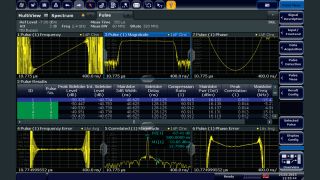Use the R&S®FSW-K6 pulse measurement application to measure amplitude, pulse width, pulse repetition interval (PRI), frequency and phase for pulsed radar measurements. The statistics for these measurements can reveal pulse-to-pulse instabilities as discussed in the radar handbook by Mr. Skolnik [2]. Pulse-to-pulse phase instability from phase noise is discussed in the Rohde & Schwarz “Pulsed phase noise measurements“ application note [3].
In addition to pulse-to-pulse statistics, the R&S®FSW-K6S time sidelobe measurement option is available within R&S®FSW-K6 to measure phase nonlinearities within a radar pulse, exposing problems in the array or further upstream in the D/A converter (DAC). Nonlinearities in linear frequency modulated (LFM) chirps could originate from integral nonlinearity (INL) in the DAC or from AM to PM conversion in the power amplifiers or PIN switches in the TRMs. The Rohde & Schwarz application card “Time sidelobe measurements optimize radar system performance” (PD 3607.2626.92) [4] explains this phenomenon.
Finally, the R&S®FSW-K60 transient analysis application as explained in the Rohde & Schwarz application note "Automated Measurements of 77 GHz FMCW radar signals” [5] can be used to analyze wideband FMCW waveforms for SAR.















